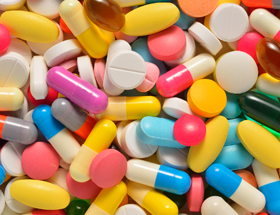 Research shows that treating ADHD is most successful when using a multi-disciplinary approach to manage the condition. This includes school accommodations, positive parenting, executive functioning coaching, and healthy habits such as adequate rest, nutrition, exercise, and often the use of medication.
Research shows that treating ADHD is most successful when using a multi-disciplinary approach to manage the condition. This includes school accommodations, positive parenting, executive functioning coaching, and healthy habits such as adequate rest, nutrition, exercise, and often the use of medication.
Medication should be considered when a child is struggling to meet academic or social expectations. It is often the glue that holds the other support pieces together to help a child succeed. Just like someone who wears glasses to help their eyes focus, ADHD medication helps kids with the condition focus their thoughts. This in turn allows them to be attentive in class or at home, stay on track with tasks, and limit distractions, hyperactivity, and impulsivity.
There are two types of medication used to treat the symptoms of ADHD: stimulants and non-stimulants.
Stimulant Medications
Stimulants are the most prescribed medication. Considered a first-line treatment, they work quickly after ingesting and reduce ADHD symptoms in 80% of children.
There are two drug classes of stimulants: methylphenidates and amphetamine. Each has two sub-types: immediate release (short-acting) and extended release (long-acting).
Each works similarly to increase dopamine and norepinephrine, two neurotransmitters that allow the brain to reduce signals from external stimuli and increase signals that help focus attention.
Stimulants are considered controlled substances because if misused or abused they can lead to addiction. But under the supervision of a healthcare provider, these medications can be safely taken, and are highly effective in reducing the symptoms of ADHD.
As with all medications, stimulants have potential side effects that usually go away after a few weeks of treatment. If, however, side effects persist, inform your healthcare provider who may change the dose or change the medication. Each person responds differently to each form of stimulant medication, and it is not uncommon to try a few medications before finding one that works best. (See below for detailed information about stimulants commonly used in clinical practice.)
Non-Stimulant Medications
Non-stimulant medications typically are prescribed when stimulants are found to be ineffective, difficult to tolerate, or are contraindicated for other reasons. They may also be considered in children with co-existing disorders or to help manage symptoms outside the timeframe of stimulants.
These medications, which can be used alone or in combination with stimulants, take time to build up in the system so results are not seen right away. In this group, there are two main types: norepinephrine reuptake inhibitors or alpha-2 adrenergic agonists.
Norepinephrine reuptake inhibitors have two medications approved for children with ADHD: Atomoxetine (Strattera™) and Viloxazine (Qelbree™). They are found to be effective in about 50% of children who take them. Results are not seen for 4-6 weeks with Atomoxetine and 2-4 weeks with Viloxazine. They are fairly well tolerated but may cause fatigue, insomnia, stomachaches, nausea, and vomiting.
Alpha-2 adrenergic agonists, first developed to treat high blood pressure, are effective in reducing ADHD symptoms in 50-60% of children who take them. They typically take 2-4 weeks to see maximum results. They are fairly well tolerated with the most common side effects being sleepiness, headache, and stomach pain. These medications are often used to help assist children with tics, aggression, and sleep problems.
Type Class Generic Name Brand Name Duration
Short Acting Methylphenidate Dexmethylphenidate hydrochloride Focalin® 4-5 hrs
Methylphenidate hydrochloride Ritalin® 8 hrs
Dextroamphetamine mixed salts
and amphetamineAdderall® 4-6 hrs
Amphetamine sulfate Evekeo® 4-6 hrs
Dextroamphetamine sulfate Zenzedi® 4-6 hrs
Long Acting Methylphenidate Serdexmethylphenidate and dexmethylphenidate Azstarys® 10 hrs
Methylphenidate hydrochloride Aptensio XR® 7-8 hrs
Concerta® 8-10 hrs
Jornay PM® 10-12 hrs
Metadate CD® 8 hrs
Metadate ER® 8-10 hrs
Quillichew ER™ 8-12 hrs
Quillivant XR® (liquid) 8-12 hrs
Ritalin LA® 8 hrs
Methylphenidate Cotempla XR® 8-12 hrs
Daytrana Patch® 10-12 hrs
Dexmethylphenidate hydrochloride Focalin® 8-10 hrs
Amphetamine Dextroamphetamine mixed salts
and amphetamineAdderall XR® 8-12 hrs
Amphetamine Adzenys ER 9-12 hrs
Adzenys XR™ ODT 9-12 hrs
Dyanavle XR® 9-12 hrs
Dextroamphetamine and amphetamine Mydayis™ 16 hrs
Vyvanse® 10-12 hrs
Vyvanse chewable 8-12 hrs
Ellen Fahey is a board-certified family nurse practitioner with a doctorate degree from Columbia University in Nursing Practice. She works at Sasco River Group in Darien CT, caring for pediatric and adult patients with ADHD and associated disorders. Dr. Fahey is also full-time faculty and assistant director of the Family Nurse Practitioner Doctor of Nursing Practice program at Columbia University School of Nursing.
